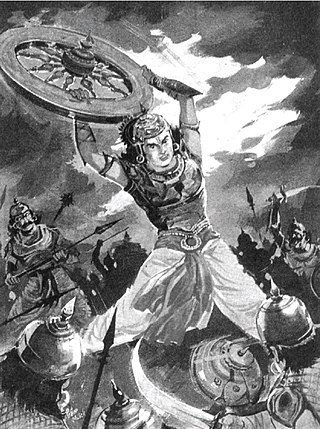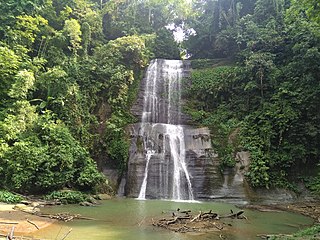Uttara, which means "north" in Sanskrit and many other South Asian languages, may refer to:
Uttara, which means "north" in Sanskrit and many other South Asian languages, may refer to:

Thane is a metropolitan city located on the northwestern side of the state of Maharashtra in India and on the northeastern side of Mumbai. It is an immediate neighbour of Mumbai city proper, and a part of the Mumbai Metropolitan Region. It is situated in the north-eastern portion of the Salsette Island.
Mohan may refer to:

Abhimanyu is a warrior in the Hindu epic Mahābhārata. He was a young and valiant warrior of the Kuru lineage, born to Arjuna—the third Pandava brother—and Subhadra—the sister of the deities Krishna and Balarama. He was also one of the few individuals, along with his father, who knew the technique to enter the Chakravyuha, a powerful military formation. Abhimanyu was raised by his maternal family in Dvārakā because the Pandavas had been exiled for thirteen years by their cousins, the Kauravas. After his father's return, his marriage was arranged with Uttarā, the princess of the Matsya Kingdom.
Kamboja may refer to:

Moulvibazar District, also spelled Moulavibazar, or Maulavibazar, is the southeastern district of Sylhet Division in northeastern Bangladesh, named after the town of Moulvibazar. It is bordered by the Indian states of Tripura and Assam to the south and east, respectively; by the Bangladeshi districts of Habiganj to the west and Sylhet to the north.
Uttarakuru is the name of a dvipa ('continent') in ancient Hindu and Buddhist mythology as well as Jain cosmology. The Uttarakuru country or Uttara Kuru Kingdom and its people are sometimes described as belonging to the real world, whereas at other times they are mythical or otherworldly spiritual beings. The name Uttara Kuru means "North Kuru". The Kurus were a tribe during the Vedic civilization of India. The Uttara Kuru were therefore a population to the north of the Kurus, but somehow some Western historians have tried to equal kuru with Himalayas and say this as north of the Himalayas.

The Bahlikas were the inhabitants of a location called Bahlika, mentioned in the Atharvaveda, Mahabharata, Ramayana, Puranas, Vartikka of Katyayana, Brhatsamhita, Amarkosha, and other ancient inscriptions. Other variations of Bahlika include Bahli, Balhika, Vahlika, Valhika, Bahlava, Bahlam/Bahlim, Bahlayana, and Bahluva.

Uttarā was the princess of Matsya, as described in the Hindu epic Mahabharata. She was the daughter of King Virata and Queen Sudeshna, at whose court the Pandavas spent a year in concealment during their exile. During this period, she learned music and dance from Arjuna, the third Pandava, and later married his son, Abhimanyu. Uttarā was widowed at a young age during the Kurukshetra War. Following the Pandavas' victory in the war, she and her unborn son were attacked by Ashwatthama, and were saved by the divine intervention of Krishna. Her son Parikshit saved the Kuru lineage from extinction, and became a well-known monarch celebrated in both the Mahabharata and the Bhagavata Purana.

Shahbagh is a major neighbourhood and a police precinct or thana in Dhaka, the capital and largest city of Bangladesh. It is also a major public transport hub. It is a junction between two contrasting sections of the city—Old Dhaka and the New Dhaka—which lie, respectively, to its south and north. Developed in the 17th century during Mughal rule in Bengal, when Old Dhaka was the provincial capital and a centre of the flourishing muslin industry, it came to neglect and decay in early 19th century. In the mid-19th century, the Shahbagh area was developed as New Dhaka became a provincial centre of the British Raj, ending a century of decline brought on by the passing of Mughal rule.
Lalbagh, also spelled Lal Bagh is a term in Hindustani and Persian language. Its meanings include "red garden" and "beloved garden".

Uttara Model Town or simply Uttara is a neighbourhood of Dhaka, the capital of Bangladesh. The name derives from the Bengali word uttor meaning "north". It lies on the road to Gazipur, and adjoins Hazrat Shahjalal International Airport.

The Mahabharata is a 1989 film version of the Hindu epic Mahabharata directed by Peter Brook. Brook's original 1985 stage play was 9 hours long, and toured around the world for four years. In 1989, it was reduced to under 6 hours for television. Later it was also reduced to about 3 hours for theatrical and DVD release. The screenplay was the result of eight years' work by Peter Brook, Jean-Claude Carrière and Marie-Hélène Estienne.

Virata Parva, also known as the “Book of Virata”, is the fourth of eighteen books of the Indian epic Mahabharata. Virata Parva traditionally has 4 parts and 72 chapters. The critical edition of Virata Parva has 4 parts and 67 chapters.

Central Asia and Ancient India have long traditions of social-cultural, religious, political and economic contact since remote antiquity. The two regions have common and contiguous borders, climatic continuity, similar geographical features and geo-cultural affinity. For millennia, there has been a flow of people, material and ideas between the two.

The Dhaka Metro Rail, or simply the Dhaka Metro, is a mass rapid transit system serving Dhaka, the capital and largest city of Bangladesh. It is operated by the Dhaka Mass Transit Company Limited (DMTCL). Together with the under construction Dhaka BRT, proposed Dhaka Subway and Dhaka suburban circular rail, it is expected to reduce traffic congestion in the city. The metro rail network has five planned lines which are the MRT Line 6, the only operational line, MRT Line 1 and MRT Line 5, which are under construction, and MRT Line 2 and MRT Line 4, which are in the planning stages. It is part of the Strategic Transport Plan outlined by the Dhaka Transport Coordination Authority (DTCA).
Motijheel is a CBD/city centre/downtown in Dhaka, Bangladesh.
Kotwali Thana named 12 Police Station in Bangladesh can refer to:
Bishan may refer to:

Uttara North is an elevated metro station of the Dhaka Metro Rail's MRT Line 6. This station is located in Uttara, a neighbourhood of Dhaka. It was opened on 29 December 2022.

The MRT Line 6 is a rapid transit line of the Dhaka Metro Rail. Despite its number, it is Bangladesh's first rapid transit line and has been in service since 2022. The line is entirely elevated and currently has 16 stations operational in service between Uttara North and Motijheel.